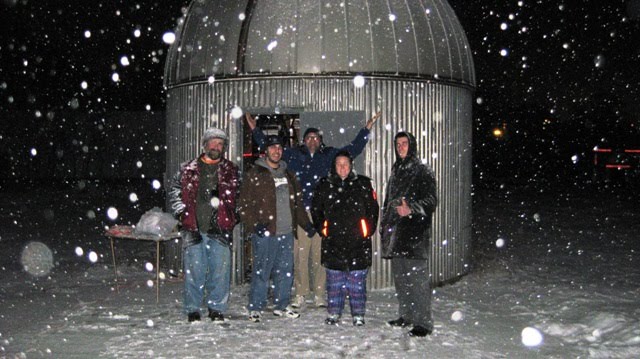Tuesday March 23, 2010:
Jim Munise and Joe Doyle showed me the shop and the places that I will be working on the Dob. But first we took a little closer look at the tailgate that opened to the mirror cell on the bottom of the Lower Assembly.
Here the mirror would sit on this circular cut of wood and be held in place by adjusting the three metal holders around the circle. This is an inconvienent platform for the mirror because it does not allow for the proper air flow that is needed to "cool down" the mirror, allowing it to adapt to the outside temperature and produce greater images.
The new design will incorporate felt circles that will lift the mirror off the flat wooden platform. This method is called "floating" the mirror, which allows for air flow to get under the mirror aiding in the ability to "cool down" quickly and efficiently.
There is a spring clamp mechanism that was put in by Jim {he estimates} about 15 years or so ago. The springs clamps still work well and will stay in the design to make sure the mirror does not slip to a side.
A fun fact about the circular piece of wood currently acting as the mirror platform:
"The table on which I drew the doodle was actually Jim's. It was as I recall a makeshift table made from a large piece of plywood used as a workbench. It was used in a class called "Lab in Astronomy" or something similar, taught by William H. Pinson." -Joe Doyle.
When we found this Joe admitted to drawing the doodle a long time ago. This is that doodle. It might not be a very clear photo but the point is that it greatly amused me.
This next picture features the Lower Assembly and the tube laying(or leaning rather) horizontally. In the picture you can see the two sets of black metal loops, a metal stick with what looks like a clamp on top and then a very long and black corner piece that extends past the Lower Assembly.
The two dark metal loops, I believe, were where the finder scope for the Dob used to be. The finder scope is a small scope with crosshairs that indicate North, South, East and West. This allows the user to locate an object or a portion of the sky in the view finder and then use the telescope to observe the area marked by the crosshairs. It is extremely convienent for this craft.
The next obscure object in the picture is the black metal corner piece that extends beyond the Lower Assembly's box. Joe thinks that someone at one point in time had a laser pointer attached to this contraption in order to help aim the scope at a particular part of the sky.
Now as for the metal stick with the clamp on its end, that was used to add weights to the bottom of the telescope in order to keep it balanced.
Now, onto the Shop photos!
This is the shop in the basement of the ConantSci building that houses most of the tools I will be utilizing in order to re-create the 17.5 inch Dobsonian truss telescope.

I took a picture of this machine because it seems like something I will be using in the near future most likely to drill holes into the hard wood truss pole holders.
There is also a room across from the shop room that is being used to store the Dob between the times that I work on it and a different room down the hall from this tool shop will be used to clean up the Dob because it has running water. But alas, that is Thursday's work.























